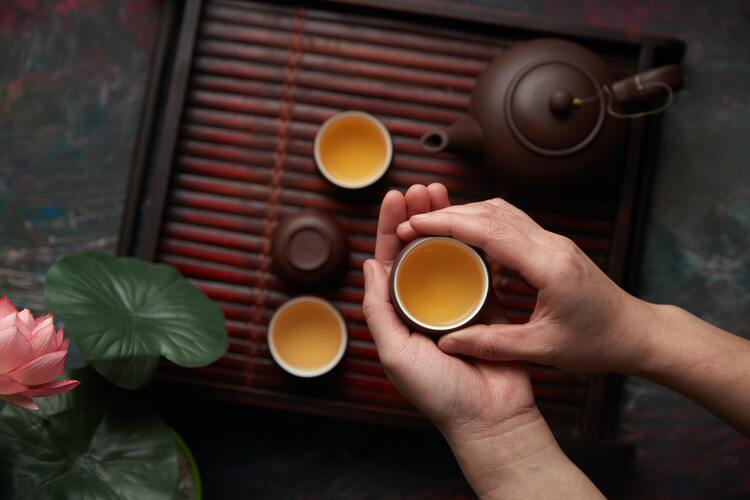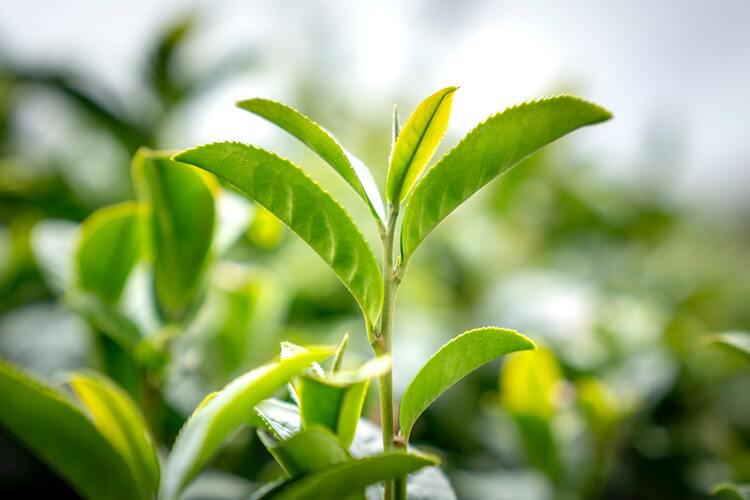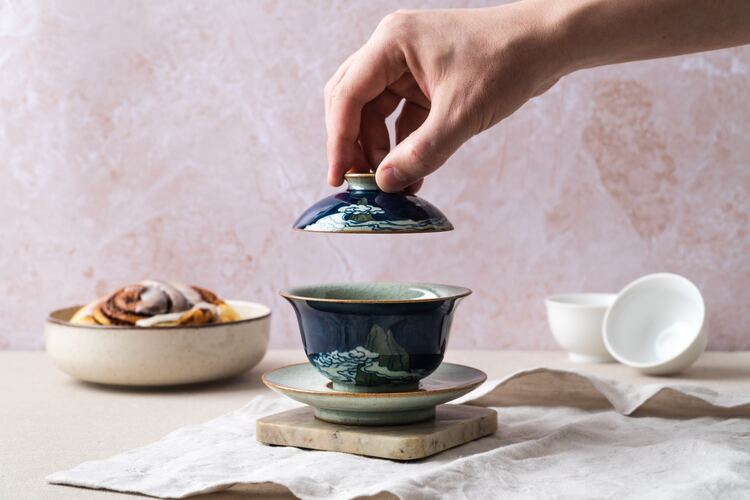Bai Ji Guan tea has been around for centuries. This type of oolong tea is grown in the Wuyi Mountains of China. It is one of the rarest and most expensive teas worldwide, making it a highly sought-after delicacy.
The name “Bai Ji Guan” translates to “White Rooster Comb” in English, referring to the tea’s leaves, which have a white downy appearance resembling a rooster’s comb.
Join us as we explore one of China’s most precious teas.

History and Legend
Bai Ji Guan tea is a rare oolong tea with many legends. The tea is one of the famous “Si Da Ming Cong” teas, which translates to “four famous bushes of Wuyi tea.”
Monk and Eagle Legend
One of the most famous legends surrounding the tea involves a monk and an eagle. The story goes that a monk was walking through the mountains when he saw an eagle circling overhead. The eagle eventually landed on a tea bush, and the monk noticed that the bush’s leaves differed from the others around it.
He picked some leaves and returned them to his temple to make tea. The tea was delicious, and the monk named the tea “Bai Ji Guan,” which means “white cock’s comb,” after the shape of the leaves.
White Rooster Legend
Another legend surrounding the tea involves a white rooster. According to the legend, a farmer was walking through his tea garden when he saw a white rooster pecking at the leaves of a tea bush. The farmer picked some of the leaves and made tea with them. It was the best tea he had ever tasted. He named the tea after the white rooster.
Despite the many legends surrounding Bai Ji Guan tea, the true history of the tea is not well documented. Whether you believe the monk and eagle legend or the white rooster legend, one thing is for sure: this rare tea is worth trying.
Geographical Significance
Fujian Province
Fujian Province is located on the southeast coast of China and is known for its tea production. The province has an extensive history of tea cultivation, dating back to the Tang dynasty (618-907 AD). The climate and soil in Fujian are ideal for growing tea, and the region produces some of the most famous teas in China, including Wuyi Oolong.
Wuyishan
The Wuyi Mountains (Wuyishan) is a region in Fujian Province famous for its tea production. The region is home to the Wuyi Tea Scenic Area, a UNESCO World Heritage Site. One of the area’s highlights is its peculiar rock formations, which create a microclimate perfect for growing tea. The tea produced in the mountains is known as Wuyi Tea (or Yan Cha or Rock Tea) and is highly valued for its flavor and aroma.
Bai Ji Guan
Bai Ji Guan is a type of Wuyi Tea. It is a rare tea that is highly prized (it is very different from other Wuyi teas). Bai Ji Guan is the most lightly oxidized cliff tea. The tea is known for its floral and fruity notes and its smooth and sweet taste.
Cultivation and Harvest
Spring Harvest
Bai Ji Guan is produced from a particular cultivar of the tea plant. It is one of the most notable cultivars native to the Wuyi Mountains.
The tea bushes are grown at high altitudes, which gives the tea its unique flavor and aroma. The best time to harvest the bushes is in the spring when the new leaves and buds are just starting to emerge.
During the spring harvest, only the new leaves and buds are picked. This is because they are the tea bush’s most tender and flavorful parts. The leaves are carefully hand-picked by experienced tea farmers, who know exactly when to harvest the tea to ensure the highest quality.
New Leaves and Buds
Bai Ji Guan tea is made from the new leaves and buds of the tea bush. These leaves are carefully harvested and then processed to create the desired flavor. The leaves are then left to wither in the sun, rolled, and dried before being roasted to bring out their flavor.
The new leaves and buds are also responsible for the unique appearance of Bai Ji Guan tea. The leaves are long and slender, with a bright green color. The buds are small and tightly curled, with a silvery-white color.
Harvest
The harvest season for this tea is short, usually only lasting a few weeks in the spring. During this time, the tea farmers worked tirelessly to pick the new leaves and buds and process them into tea. The tea is then carefully packaged and shipped to tea drinkers worldwide.

Processing Highlights
The processing of Bai Ji Guan tea involves several steps crucial to the tea’s final flavor and aroma.
As an overview, oolong teas go through the following steps in the production process:
- Withering
- Tossing
- Oxidation
- Firing
- Rolling
- Drying
- Roasting
The order of the steps and the approach used in each step vary. However, I am presenting these steps because, for other Wuyi teas (like Shui Jin Gui and Tie Luo Han), there is a lot of emphasis on the roasting step.
On the other hand, Bai Ji Guan goes through a gentle roasting period (vs hours of roasting or multiple roasting times).
Also, the tea is unique in that it is a lower oxidized oolong tea. This means the tea leaves are only partially oxidized, giving the tea a lighter flavor and aroma than fully oxidized oolong teas.
During Bai Ji Guan tea processing, the tea leaves are also rolled and shaped into small, tight balls. This rolling process helps to release the essential oils in the tea leaves.
Characteristics
Visual Appearance
Bai Ji Guan tea leaves are dark green with yellow-green edges. The leaves are long and narrow, with a curved tip that is slightly twisted. When brewed, the leaves unfurl and release their full flavor.
Remember that these green-yellow colors contrast with other dark oolongs from the Wuyi Mountains.
Aroma
The aroma of Bai Ji Guan tea is one of its most notable characteristics. It has a delicate, floral fragrance that is both refreshing and invigorating. The vegetal aroma of this tea is also present, adding a subtle earthiness to the overall scent.
Flavor
Bai Ji Guan tea has a complex flavor that is both fruity and creamy. The taste is smooth and refreshing.
Here is a detailed description of the flavor profile:
- Floral: The tea can exhibit floral notes, often reminiscent of orchids or magnolias.
- Fruity: The tea may have hints of fruity flavors, which can vary but often include subtle notes of ripe peach, apricot, or lychee. These fruity undertones add a sweet touch and enhance the tea’s complexity.
- Mineral: Bai Ji Guan tea is known for its mineral character. It can have earthy or rocky undertones, reminiscent of the rocky terrain of the Wuyi Mountains where it is grown. This mineral aspect adds depth to the flavor profile and provides a sense of terroir.
- Smooth and Mellow: The tea is generally smooth and mellow on the palate, with a clean and refreshing mouthfeel. It lacks the astringency often found in other oolong teas, making it more approachable and enjoyable for a wider range of tea drinkers.
- Lingering Aftertaste: Bai Ji Guan tea leaves a lingering, sweet aftertaste. This pleasant aftertaste is considered one of its desirable qualities.
Brewing Bai Ji Guan
Gong Fu Brewing Method
If you want to enjoy the full flavor of Bai Ji Guan, then the Gong Fu brewing method is recommended. This method involves using a small teapot (Yixing clay teapot) and brewing the tea in multiple short infusions. This brewing method ensures the best taste. Here’s how you can do it:
- Preheat your teapot and cups by rinsing them with hot water.
- Add the tea leaves to the teapot. The amount of tea leaves will depend on the size of your teapot, but a general guideline is 1-2 teaspoons of leaves for every 6-8 ounces of water.
- Pour hot water over the tea leaves and immediately pour it out. This helps to rinse the tea leaves and awaken their flavor.
- Refill the teapot with hot water and steep it for about 20-30 seconds.
- Pour the tea into your cups and enjoy the fragrant aroma and delicate taste.
- Repeat steps 4 and 5 for multiple infusions, gradually increasing the steeping time with each infusion. You can increase each infusion’s steeping time by 10 to 20 seconds.
Please pay attention to the last step. You can (and should) infuse your oolong tea multiple times. Please make the most out of it!
Gaiwan Brewing Method
You can use a gaiwan to brew tea as well. A gaiwan is a traditional Chinese tea vessel that allows you to control your tea’s temperature and steeping time. Here’s how to use it:
- Warm the gaiwan and tea cups with hot water,
- Add the tea leaves to the gaiwan. Use 1-2 teaspoons of leaves for every 6-8 ounces of water.
- For heavily roasted oolongs, pour hot water over the tea leaves and immediately pour it out. This helps to rinse the tea leaves and awaken their flavor.
- Slowly pour water over the leaves till the rim of the gaiwan.
- Add the lid and steep for 20-30 seconds.
- Pour the tea into teacups. While doing this, hold the gaiwan with your thumb and middle finger. Secure the lid with the index finger.
- Repeat the process with multiple infusions.
Western Style Brewing
If you prefer to brew tea using Western methods, start by heating the water. Put one teaspoon of tea leaves into a tea infuser or strainer and place it in a cup. Pour the hot water over the leaves and let it steep for about 3-4 minutes. Remove the infuser or strainer, and enjoy your tea.
Ideal Water Temperature
The water temperature plays a crucial role in brewing this tea. If the water is too hot, it can burn the delicate tea leaves and ruin the flavor. On the other hand, if the water is too cold, it may not extract the full flavor of the tea leaves. Here’s the ideal water temperature for brewing this particular tea:
- Bring fresh, cold water to a boil.
- Let it cool down for 2-3 minutes until the water temperature reaches around 190-200°F (88-93°C).
- Pour the hot water over the tea leaves and let it steep for the desired time.
Remember to use fresh, cold water that is free of any impurities. Avoid tap water if possible, as it may contain chlorine or other chemicals that can affect the taste of your tea.

Health Benefits
Bai Ji Guan tea is a delicacy and has numerous health benefits. Here are some of the benefits of drinking this tea:
- Rich in polyphenols: Polyphenols are natural compounds that have antioxidant properties. Antioxidants help to protect your cells from damage caused by free radicals, which can lead to chronic diseases such as cancer and heart disease.
- Boosts metabolism: Contains caffeine, which can help to boost your metabolism and increase your energy levels. This can be particularly useful if you are trying to lose weight or improve your exercise performance.
- Promotes relaxation: Contains an amino acid called L-theanine, which has been shown to promote relaxation and reduce stress levels. This can help to improve your overall mood and reduce feelings of anxiety.
- Supports healthy digestion: Bai Ji Guan tea has been shown to positively affect digestion by increasing the production of digestive enzymes and reducing inflammation in the gut. This can help to alleviate symptoms of digestive disorders such as bloating, constipation, and diarrhea.
- May reduce the risk of chronic diseases: Some studies have suggested that drinking tea may help to reduce the risk of chronic diseases such as cancer, heart disease, and diabetes. However, more research is needed to confirm these findings.
Frequently Asked Questions
What are the health benefits of Bai Ji Guan Tea?
Bai Ji Guan is known for its numerous health benefits. It is rich in antioxidants, which help to protect your body from harmful free radicals. It can also help boost your metabolism, aiding in weight loss. Additionally, this has been shown to help reduce stress and improve mental clarity.
How does Bai Ji Guan Tea differ from other oolong teas?
Bai Ji Guan is a unique type of oolong tea grown in the Wuyi Mountains of China. It has a distinct flavor profile sets it apart from other oolong teas. It is known for its floral aroma, sweet taste, and smooth finish. Additionally, Bai Ji Guan Tea is less oxidized than other oolong teas, which gives it a lighter and more delicate flavor.
What is the best way to prepare Bai Ji Guan Tea?
To prepare the tea, it is recommended to use water between 195-205°F. Steep the tea for 2-3 minutes or until it reaches your desired strength. The tea can be enjoyed alone or with a touch of honey or lemon.
Where is Bai Ji Guan Tea grown?
Bai Ji Guan is grown in the Wuyi Mountains of China. This region is known for its unique terroir, which gives the tea its distinct flavor profile. The Wuyi Mountains are also a UNESCO World Heritage Site, highlighting the region’s cultural and historical significance.
What are the flavor notes of Bai Ji Guan Tea?
This tea has a complex flavor profile characterized by its floral aroma, sweet taste, and smooth finish. It has notes of honey, orchid, and apricot, with a subtle hint of smokiness.

I hope you enjoyed the article and learned something new. See you next time!
Have you tried this tea?